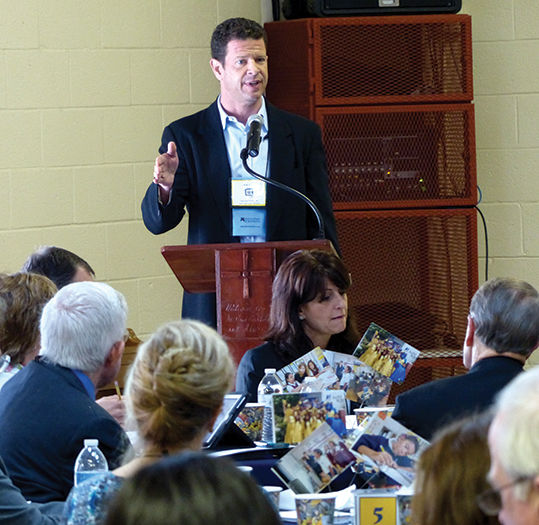“Log off,” said the teacher to the kindergartners on laptops at one end of the classroom as she rang a bell signaling rotation time at St. Anne School in Santa Monica.
The ten five-year-olds --- who had each been working at their own pace with a digital reading program --- logged out of their laptops, took off their headphones and proceeded to their teacher’s table just vacated by other classmates headed either for the laptop stations or their worksheet session at the classroom aide’s table.
It was just a normal “blended learning” day at St. Anne School, which hosted the 2014 Los Angeles Blended Learning Summit for more than 100 Catholic school educators Feb. 11 to showcase this new educational model implemented in all of its K-8 classrooms this school year.
St. Anne was selected last summer after a year of research, planning and fundraising by its principal, Michael Browning, and administrators to become the first Catholic elementary school in Los Angeles to fully implement blended learning as a part of Seton Education Partners’ expansion of its Phaedrus Blended Learning Initiative to Los Angeles.
Blended learning, in fact, represents a colossal change in education from the one-size-fits-all classroom model, said Frank Baxter, board co-chairman of the Alliance for College-Ready Public Schools (a charter management organization with six middle schools and 16 high schools in low-income L.A. neighborhoods), who gave the keynote address at the Summit.
“Public schools and Catholic schools were locked in a paradigm of the industrial age when the information age evolved,” said Baxter, chairman emeritus of the global investment bank, Jefferies and Company Inc. and former U.S. Ambassador to Uruguay (2006-2009). “If the hero of the industrial age, Henry Ford, were to come back today, the only thing he would recognize is our public and Catholic schools.”
He noted that when Apple gave computers to schools in the ’70s, educators’ reaction was to keep the old industrial standardized educational system and place the computers in a lab or the school library. “So the old system went on,” he said. “But in the last few years, it started occurring to people, ‘Why don’t we change the paradigm?’ And the paradigm is called blended learning.”
He described blended learning’s characteristics as being personalized, borrowing from the pre-industrial age model of tutoring; enabling students to go at their own digital learning pace; and allowing teachers, through technology, to have daily assessments that are more diagnostic than just based on a student’s testing scores.
“Instead of being a ‘sage on the stage,’ the teacher is a partner in that child’s education,” said Baxter. “It’s amazing how in such a short time, the students change. They start taking ownership of their own education and they interact, and we can track whether they’re studying our curriculum online.”
He praised St. Anne for setting the blended learning example for archdiocesan Catholic schools. “It’s really critical to get into the 21st century as soon as possible because Catholic schools are so important, not just for Catholics but for everyone because they focus on ethics and service,” said Baxter.
Scott Hamilton, chair and co-founder of Seton Education Partners who previously designed the Knowledge is Power Program (KIPP) implemented in 140 of America’s best known inner-city public schools, told the assembled Catholic educators that they have the opportunity to use technology to improve their schools.
“I think we have the obligation to leap into the 21st century and combine that [Catholic school] tradition with the new tools,” said Hamilton. Noting that an important historical strength of Catholic schools was “social capital,” he pointed out that employers today are not only looking for cognitive skills but positive character traits fostered in Catholic schools.
“Combining the amazing opportunity of digital learning with the teaching and strengthening of these [Catholic] values is really important for the future of these kids, really important for their job prospects and really important for their relationship with God, which is also a key part of our job,” said Hamilton.
Cindi Smith, St. Anne’s third grade aide who has been with her students since they were kindergartners, told The Tidings that she has seen the third graders make great strides this year with blended learning.
“There would be some children who were so far advanced, there was no place for them to go,” recounted Smith. “So in their younger [grades], they would just be given books after they finished a worksheet, because the teacher couldn’t really pay any more attention to them for their level.
“Now I see these children being engaged and going to the level that they can achieve, not being held back, so I think it’s a fantastic program. Generally speaking, [the teacher’s] attention is now in half of the class, which makes that even more dynamic for the kids who are learning directly from her, and the other children are progressing at their own pace. So it works really well.”

